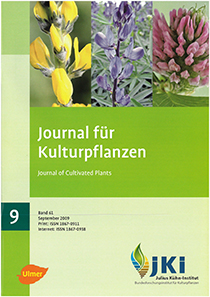Grain legumes – state of knowledge and need for future research from the view of organic farming
DOI:
https://doi.org/10.5073/JfK.2009.09.06Keywords:
Grain legumes, N fixation, weed control, mixed cultivation, research needs, organic farmingAbstract
Grain legumes should be a permanent component of the crop rotations in organic farms due to their positive characteristics (N-fixation, energy savings, humus development, nutrient mobilization). They are the most important source of protein in feedstuffs in organic animal husbandry.
The total German crop area planted grain legumes has for years been dropping significantly. The percentage of organically grown grain legumes on the total area continues to increase, and has now reached, in the case of field beans and lupines, more than 40%. But even in organic farming the portion of grain legumes on the completely organically-farmed arable land area has been dropping for years. In 2008, this was only 6.2 percent of the organically farmed cropland.
From a crop science perspective, in organic farming the most important function of grain legumes is the ability to fix nitrogen. Nitrogen fixation is, however, dependent on a range of factors including weather, location, legume portion in the mixture, etc. The exactness of estimate processes used to calculate the nutrient balancing must be improved.
Weed control in grain legume crops is more difficult than in grain crops due to the slow early development of the plants and the lower level of weed suppression linked to it. Of the curry combs available, the roller-type curry comb can be used at an early point in time. The indirect measures, such as choice of varieties in peas or lupines, should be considered more seriously.
The mixed cropping system is a further possibility for indirect weed regulation. Both the yields and yield security can be increased at the same time with such cropping systems. Particularly suitable are mixtures of fodder peas and barley or oats, or field beans and oats.
Future research needs are above all in the area of breeding (protein quality, resistance, winter forms); crop sequence research on phyto-sanitary aspects, optimization of crop systems and the use of grain legumes in human nutrition.
Downloads
Published
Issue
Section
License
The content of the journal is licensed under the Creative Commons Attribution 4.0 License. Any user is free to share and adapt (remix, transform, build upon) the content as long as the original publication is attributed (authors, title, year, journal, issue, pages).
The copyright of the published work remains with the authors. The authors grant the Journal of Cultivated Plants, the Julius Kühn-Institut and the OpenAgrar repository the non-exclusive right to distribute and exploit the work.







